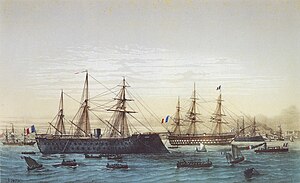French ironclad Magenta

| |
| History | |
|---|---|
| Namesake | Battle of Magenta |
| Builder | Brest |
| Laid down | June 22 1859 |
| Launched | June 22 1861 |
| Fate | Exploded on 31 October 1875 |
| General characteristics | |
| Class and type | Magenta-class broadside ironclad |
| Displacement | 7,129 tonnes |
| Propulsion | list error: <br /> list (help) Sail 1,000 HP steam engine, 8 boilers |
| Speed | 12 knots |
| Endurance | 3 months of food, 700 tonnes of coal |
| Complement | 681 men |
| Armament | list error: <br /> list (help) 10 × 240mm guns 4 × 190 mm guns |
The Magenta was a broadside ironclad of the French Navy, lead ship of her class.
The Magenta served as flagship of the Mediterranean squadron.
On 31 October 1875, a fire started aboard. The crew attempted to wet the gunpowder magazines and fight the fire, to no avail. When it became clear that the ship could not be saved, the crew abandoned ship, and the Magenta exploded shortly after. She sank in 15 metres of water in the military harbour of Toulon.
At the time of the accident, Magenta had a cargo of Carthaginian antiques, notably 2080 punic stelae (Tophet, 2nd century BC) and a marble statue of Vibia Sabina (Thasos, c. 127-128 AD), found in 1874 by the Pricot de Sainte-Marie mission.
The wreck was located in April 1994. Fragments of stelae have been since recovered.[1] The statue has been partially recovered, though the head was too damaged to be rejoined to the rest of the statue. The fragments are on display at the Louvre. [2]
